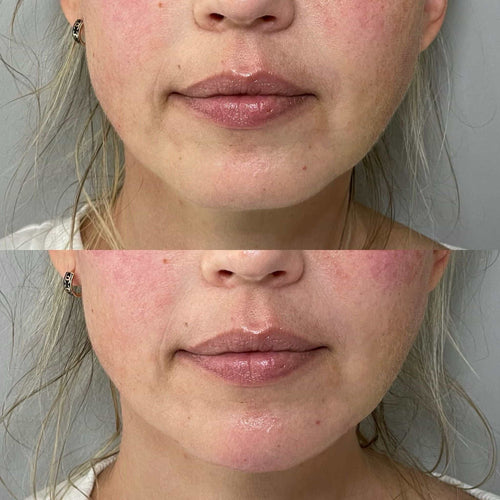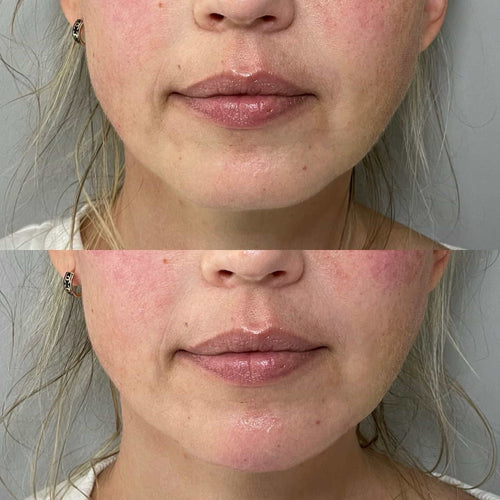Get Your Dermal Filler Consultation with Dr. Laura Geige at It’s Me and You Clinic

Understanding Jowls
Causes of Jowls
Jowls are folds of skin that appear along the jawline, extending from the corners of the mouth down towards the neck. They are a common concern as we age, often making people look tired or older than they feel.

There are several factors that contribute to the development of jowls:
- Loss of Facial Fat and Muscle Tone: As we age, our bodies naturally produce less collagen and elastin, the proteins responsible for maintaining skin’s elasticity and firmness. This loss of support allows the facial tissues to sag, resulting in jowls.
- Genetics:** Some people are genetically predisposed to develop jowls earlier than others.
- Sun Damage: Prolonged exposure to the sun’s ultraviolet (UV) rays can break down collagen and elastin, leading to wrinkles, sagging skin, and jowls.
- Smoking:** Smoking accelerates aging by damaging collagen and elastin fibers.
- Weight Gain and Loss: Fluctuations in weight can cause the skin to stretch and lose its elasticity, potentially leading to jowls.
While jowls are a natural part of aging, there are ways to address their appearance. These options range from non-invasive procedures like fillers and lasers to surgical interventions like facelifts.
Jowl Appearance Over Time
Jowls are folds of skin that form along the jawline when the underlying fat and connective tissue lose support over time. They appear as sagging or drooping flesh, creating a noticeable contour change around the face.
As we age, several factors contribute to jowl development:
1. **Fat Loss:** The face naturally loses volume with age, particularly in areas like the cheeks and temples. This redistribution of fat can cause the jawline to appear less defined and lead to jowling.
2. **Collagen Breakdown:** Collagen is a protein that provides structural support to skin, keeping it firm and elastic. Collagen production declines as we age, resulting in thinner, weaker skin that sags more easily.
3. **Muscle Atrophy:** The muscles that support the jawline also weaken with age. This loss of muscle tone further contributes to sagging skin.
4. **Genetics:** Some individuals are genetically predisposed to jowling, meaning they may develop these folds earlier in life than others.
5. **Sun Damage:** Exposure to ultraviolet (UV) radiation from the sun can damage collagen and elastin fibers, accelerating skin aging and increasing the likelihood of jowls.
The appearance of jowls is a natural part of the aging process, but lifestyle factors can influence their severity. Maintaining a healthy weight, protecting your skin from the sun, and eating a balanced diet rich in antioxidants may help minimize jowl formation.
Dermal Fillers for Jowls
How Dermal Fillers Work
Jowls, those soft folds that appear along the jawline, are a common sign of aging. As we get older, our skin loses volume and elasticity, causing fat to sag and create these unwanted creases.
Dermal fillers can be an effective way to address jowls by restoring lost volume and contour.
These fillers are made from hyaluronic acid (HA), a naturally occurring substance in the body that helps keep skin plump and hydrated. HA fillers work by attracting and holding water, adding fullness and smoothing out wrinkles and folds.
During a dermal filler treatment for jowls, the practitioner will inject the filler strategically along the jawline, lifting and defining the area.
The results are typically immediate and can last anywhere from six months to two years, depending on the type of filler used and individual factors.
Secure a Dermal Filler Appointment with Dr. Laura Geige Today
While cheek fillers primarily address volume loss in the cheeks, they might indirectly improve the appearance of jowls by creating a more balanced facial profile.
By plumping up the cheeks, cheek fillers can help to counterbalance any downward pull on the lower face.
However, it’s important to note that cheek fillers are not specifically designed for treating jowls and may not produce dramatic results in this area.
For more targeted jowl correction, dermal fillers injected directly into the jowl area are generally a more effective solution.
Get a Dermal Filler Consultation with Dr. Laura Geige at It’s Me and You Clinic
Types of Fillers Suitable for Jowls
Jowls, those sagging areas of skin that extend from the cheeks down towards the jawline, are a common concern as we age. While cheek fillers can plump up cheeks and create a more youthful contour, they may not directly address jowl concerns.
Dermal fillers designed for addressing jowls typically work by strategically volumizing and lifting the tissue to counteract sagging. Unlike cheek fillers which often focus on adding volume and definition to the apple of the cheek, jowl filler injections target the area below the cheekbone, aiming to restore lost support and minimize the appearance of folds and creases.
The most suitable types of dermal fillers for jowls are generally hyaluronic acid-based fillers. These fillers offer a combination of immediate volume enhancement and gradual tissue stimulation, promoting collagen production over time. They are considered biocompatible and reversible, meaning they can be dissolved if needed.
Some popular hyaluronic acid fillers used for jowl treatment include:
• **Juvederm Voluma:** Known for its long-lasting results and ability to provide significant volume restoration.
• **Restylane Lyft:** Designed for adding fullness and lifting the midface, which can indirectly help improve jowls.
• **Radiesse:** This calcium hydroxyapatite filler offers both immediate volumization and longer-term collagen stimulation.
Choosing the right filler depends on individual needs, skin thickness, desired outcome, and the provider’s expertise. A thorough consultation with a qualified practitioner is crucial to determine the most suitable filler type and treatment plan.
Considerations Before Treatment
Consultation with a Qualified Provider
Before deciding on any cosmetic treatment, including cheek filler for jowling, it’s crucial to carefully consider your individual circumstances and expectations.
Firstly, understand that cheek fillers are not a permanent solution. They gradually break down over time, typically lasting 6-18 months depending on the type of filler used and individual factors like metabolism.
Next, assess your jowling severity. Mild jowls might improve with minimal filler, while more pronounced cases may require multiple sessions or combination treatments.
It’s essential to have realistic expectations about the potential outcomes. Cheek fillers can enhance cheek volume and lift, potentially minimizing the appearance of jowls, but they won’t completely eliminate them or provide a drastic makeover.
Consider your overall facial anatomy and skin condition. Fillers may not be suitable for everyone, especially those with certain medical conditions like allergies, autoimmune disorders, or bleeding disorders.
Research different types of fillers available and their potential side effects. Some common side effects include bruising, swelling, tenderness, and redness, which typically subside within a few days to weeks.
Financial considerations are also important. Cheek filler treatments can be costly, and multiple sessions may be needed for optimal results.
Finally, consulting with a qualified and experienced cosmetic provider is paramount. A thorough evaluation of your facial structure, skin type, and medical history will help determine if cheek fillers are appropriate for you and what the best treatment plan would entail.
During the consultation, don’t hesitate to ask questions about the procedure, potential risks and benefits, recovery time, and cost.
Realistic Expectations and Potential Side Effects
Considering any cosmetic procedure, it’s crucial to have a clear understanding of potential outcomes and risks involved.
For cheek fillers specifically addressing **jowls**, there are several factors to consider before treatment.
**Considerations Before Treatment:**
• ***Medical History***: It’s essential to disclose any underlying medical conditions, allergies, or medications you’re taking to your doctor. Certain health issues or medications might make cheek filler injections unsafe.
• ***Realistic Expectations***: While cheek fillers can augment facial volume and potentially improve the appearance of jowls by creating a more lifted effect, they won’t completely eliminate them. Understand that results vary depending on individual anatomy and skin elasticity.
• ***Skin Type and Quality***: The effectiveness of cheek fillers may differ based on your skin type. Thinner skin might show bruising or swelling more prominently.
• ***Desired Outcome***: Discuss your goals with your doctor to determine if cheek fillers are the appropriate treatment option for you. They can help you understand what’s achievable and realistic.
• ***Technique and Practitioner Experience***: The skill and experience of the injecting practitioner play a significant role in achieving natural-looking results and minimizing risks.
**Realistic Expectations:**
Cheek fillers can provide noticeable improvements in facial contour, adding volume to the cheeks and potentially reducing the appearance of jowls. However, it’s crucial to remember that:
• ***Individual Results Vary***: The extent of improvement depends on factors like age, skin laxity, and the amount of filler used.
• ***Gradual Results***: You may not see the full results immediately. Swelling typically subsides within a few days to a week, allowing the final outcome to become apparent.
• ***Temporary Solution***: Cheek fillers are not permanent. The effects usually last between 6 months to 2 years, depending on the type of filler used and individual metabolism.
**Potential Side Effects:**
As with any medical procedure, there are potential side effects associated with cheek filler injections. These typically include:
• ***Bruising and Swelling***: This is common and usually resolves within a few days.
• ***Pain and Discomfort***: Mild pain or soreness may occur at the injection site.
• ***Redness***: Temporary redness can also occur around the injection area.
• ***Infection***: Although rare, there’s a risk of infection if proper sterilization techniques are not followed.
• ***Lumps or Nodules***: These can sometimes form if the filler is not injected correctly.
Mind Plus Motion The Lady London Goonie Yoga and Therapy Reimagining Journalism Melissa Neufeld
- Why Do Men Like Breasts? Find Out The Real Reason - July 5, 2025
- What To Eat Before Lip Filler - July 2, 2025
- What Is Barbie Botox? - June 29, 2025
